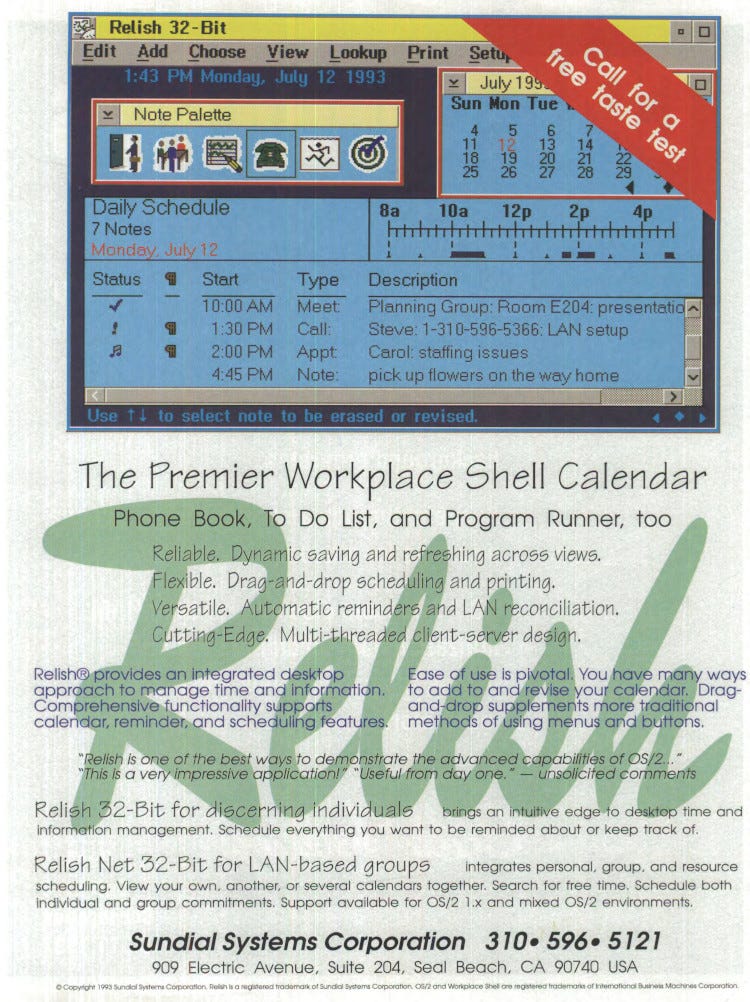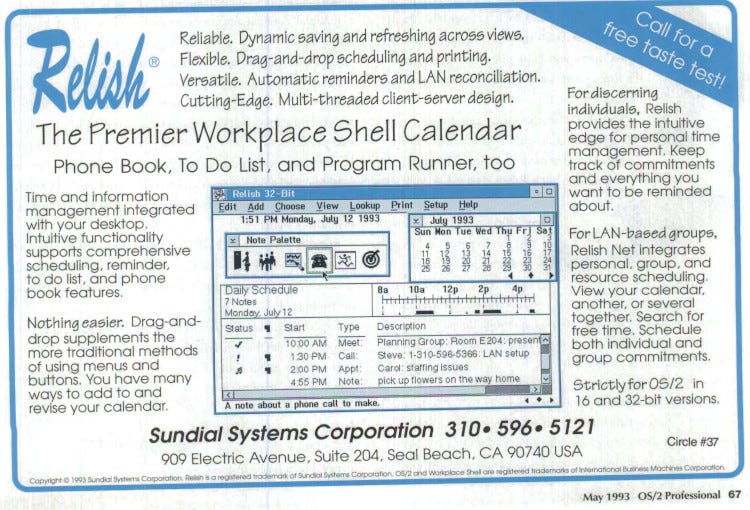Sundial Systems' Relish
The Premier Workplace Shell Calendar, Phone Book, To Do List, and Program Runner, too
I figured it was time to give OS/2 some love.
The Company
Sundial Systems Corporation was incorporated in July of 1988. The company was dissolved over 20 years later in 2009. Opencorporates lists two directors/officers of the company: Randell S. Flint and Carla Hanzlik. With these two names, I decided to do some more research.
EDM2 (an OS/2 magazine turned wiki) had an entry for Randell S. Flint. It states:
“The late Dr. Randell S. Flint was the president of Sundial Systems Corporation. As the chief architect of the PIM application Relish, he was deeply involved with OS/2 ever since the release of version 1.0 and advocated taking advantage of all it has to offer. Prior to founding Sundial Systems in 1988, he was involved in consulting for NASA's Jet Propulsion Laboratory, acted as system architect for a database server start-up firm, and, at one time was an assistant professor of computer science.
Dr. Randell also co-founded the Southern California OS/2 User Group in 1993 alongside Carla Hanzlik and Rollin White in 1993 and frequently gave talks there.
Sadly Dr. Randal S. Flint passed away on October 5, 2007.”
The OSWWorld.com wiki has less information about Flint but does note that he was married to Carla Hanzlik. Now we know that Sundial Systems was a family business and that it was dissolved shortly after his death.
As mentioned above, Flint and Hanzlik (and their employees) were also involved with the Southern California OS/2 User Group. One of the group members interviewed Flint in 1996 for a short article on the SCOUG site entitled “It's Sundial Time - Words, Numbers, and Organization Too”. In the beginning, Peter Skye writes, “So, right up front, here's the disclaimer: Dr. Randell Flint, President of Sundial Systems, is a member of SCOUG. Rollin White, Product Manager (and programmer) at Sundial Systems, is President of SCOUG. Carla Hanzlik, Vice President of Marketing at Sundial Systems, is Editor-In-Chief of this very publication, a SCOUG product. But I don't work for Sundial…Besides, Dr. Randell Flint didn't want me to tell anyone that he has a Ph.D., so if there was ever a chance I'd get a free copy of Mesa 2, I've blown it now.”
Skye scattered more information about Flint and the history of Sundial throughout the article:
“Sundial was formed in the spring of 1987, the same week as the premier OS/2 announcement. Randell saw, as other visionaries did, that a platform as sophisticated as OS/2 would require sophisticated programs, and eighteen months later he shipped what became Relish. Did I tell you that Dr. Flint got his Bachelor of Science in Information and Computer Science at UC Irvine, that he did it in three years instead of four, and that he graduated magna cum laude? Oooh, he's going to hate me.
…
Did I mention that Dr. Randell used to be a professor at Cal State Fullerton? Filling the minds of the young and naive with the likes of this two-liner: "Microsoft is always saying 'This is what's coming, and it will solve all the world's problems.' As users begin to get the idea that there's a flaw in the Microsoft marketing machine, they'll tire of being burned." Now, now, Professor Flint, you didn't want me to mention your classroom lectures, either? It must have just slipped my mind.
…
Sundial, in fact, is the foremost OS/2 software vendor in terms of breadth of product line. They're also one of the oldest, since they and OS/2 were born together. They're not expensive - in fact, their apps are priced similar to Windows apps which don't (and can't) do what OS/2 apps do. All of their products have free demos available for download. And they have free tech support by phone, fax, CompuServe, BBS, Web, and Email.
Randy really opened up during this interview, and told me lots of stuff I never expected. Not only did he tell me things he didn't want printed, he also told me things he never thought someone would bother printing. For example, he even told me his birthday and year of birth. It's ¤>.¤>.¤>. Yes? Please come in! Why, Mr. Flint, so good of you to drop by so unexpectedly! Sit down, make yourself comfortable, and while you do, could you lower the barrel on that shotgun?”
Sundial was also written up in OS2Voice. In the article, Per Johansson wrote, “It may be fun to create OS/2 applications, but not so much profit these days. However, one ISV (Independent Software Vendor) called Sundial Systems offers no less than six applications with the end users in mind. This company is well known among OS/2 users…The company is based in the Los Angeles area, USA. They have been around since 1988, and the people involved have been working with OS/2 since the beginning.”
If you are interested in OS/2 software development, Randell S. Flint published a couple of articles on the topic:
The Product
Now let’s talk about the application.
The October 1994 issue of OS/2 Magazine carried this description of Relish 2.12:
“Relish is a personal time-management program designed to help individuals keep track of their appointments, to-do lists, scheduled phone calls, and more. It’s an ideal tool if you’re able to work with a time-management program (and not everyone is). The payback is that, if you can use a computer to manage your time, Relish’s phone book, calendar reports, and automatic notifications can keep you well-connected and well-organized.
OS/2 users like Relish’s Workplace Shell integration, complete with drag-and-drop functionality. They’ve found it useful for coordinating many time-critical events, on individual desktops and through a network.”
In December of the previous year, the same magazine reviewed three time management programs for OS/2 including Relish. Here are a couple of excerpts:
“Sundial Systems’ Relish supports more event types than the usual appointments and To-Do lists. You can schedule meetings, appointments, To-Do list items, notations, phone calls, and program launches. All events appear on one central list. Just about any way that you think is an obvious way to create a new item will work: double-click on an icon in the Note Palette, drag it to the date in the calendar display, drag it to the time on the time bar, or select Add Phone Call from the menu.
Drag-and-drop is fully implemented within the program and in its interaction with OS/2. You can drag an appointment to the desktop or you can drop a phone call on the daily time line to schedule a new phone call. To change a font in Relish, use the OS/2 font palette. Relish’s integration into the Workplace Shell is superb.
…
Relish’s biggest handicap is its time-dependence. Every item must have an associated time. You can’t create an item to Call Ross Perot today without associating a time that you intend to make the phone call. Also, unfinished To-Do items don’t automatically move forward to the next day.
Relish’s phone book is simple, with room for a name, address, and remarks. You can enter several phone numbers and descriptions.”
The October 1994 issue of OS/2 Professional announced the release of Relish 2.2:
“Sundial Systems Corporation last month began shipping Relish 2.2, the company’s first SOM-based PIM for OS/2. This new version includes a collection of Workplace Shell objects called “buns” (where else does one put relish?). These objects are various ways that information can be viewed, copied, moved, or stored, providing point-and-click access to calendars, phone books, and schedules. The Type-to-Search function provides searching on demand—just start typing (a client’s name, for example) and the software will scroll to the appropriate phone book entry. Other new features include an optional icon bar for one-click access to functions and a “floating notes” feature that allows an entry to float from one day to the next without being locked into a specific time frame.
The single-user version is available to registered 2.1 users for $22; new users pay $89. The company plans to ship a network-ready version by the end of this month.”
Let’s go back to Peter Skye’s article about Sundial. It has some information about Relish from the creator himself:
“I'm constantly amazed at what an OS/2 program can do that a Windows program can't. Relish is network-ready; put the databases anywhere at all. It's both faster and more effective than equivalent Win 3.x and Win95 apps because the "design point" is different. For example: in Relish, reminders pop up as scheduled (in Windows, you have to run the program each time you want to see your reminders!). OS/2 is different, the desktop is different, and Relish is therefore always "running". Multiple views of data are allowed in real time - change one entry and all views instantly change, even on other terminals - because OS/2 manages the messages. It works great, and always has, on remote terminals over networks. Relish tasks don't have to "poll" for updates; there's no polling anywhere. (Mr. R.F. didn't want me to tell you this, because it's a "trade secret", but I don't mind sharing such a small little tidbit with my friends.)
US Air uses Relish to schedule all their in-flight entertainment. Help desks use Relish to schedule their call-backs. One major telco used it to schedule customer callbacks. Here's a great one: oil field production reports were generated automatically at a specific time by Relish with the program scheduling feature. And with the new Relish Web, you can access, view and update your own Relish files from any browser on any platform. Great for on-the-road updates from someone else's machine, and especially if you're using Relish for a group scheduler or project management which requires access by several people. Run it on your LAN as an Intranet. Any change you make shows up instantly on every other user's screen that has a Relish view.
The Relish code is essentially bullet-proof. One of Randell's favorite stories is about a user who lost an entire disk cluster out of the middle of a file (done by an errant Windows program, no doubt), and Relish kept working. File integrity is constantly checked, and there's a maintenance program to run if you ever have a really big disaster.”
More Information
Here is some extra information that I came across that you might find interesting:
Archived version of Sundial’s website
Relish’s entry on OS2World.com
Several archived versions of Relish
Have you ever used Sundial Systems' Relish? Do you know anything about its history? Tell us about it in the comments below.










